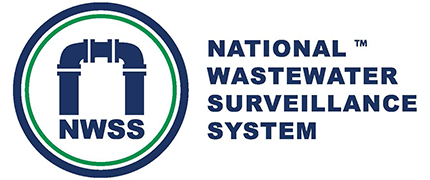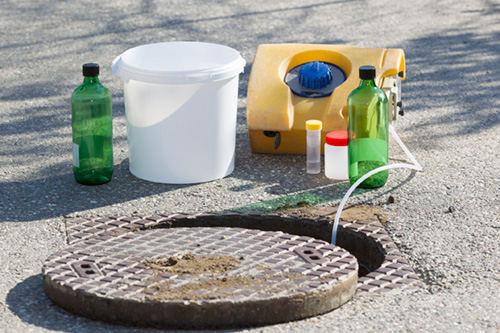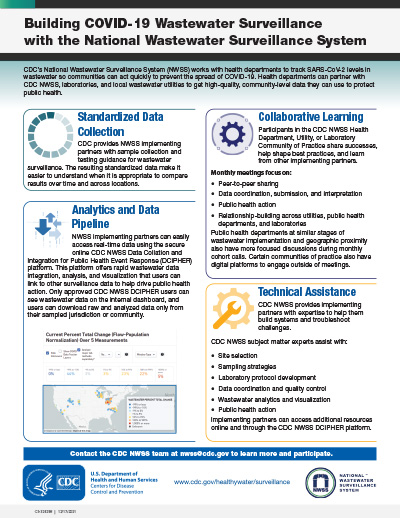National Wastewater Surveillance System (NWSS)
A new public health tool to understand COVID-19's spread in a community
In response to the COVID-19 pandemic, CDC launched the National Wastewater Surveillance System (NWSS) in September 2020. CDC developed NWSS to coordinate and build the nation’s capacity to track the presence of SARS-CoV-2, the virus that causes COVID-19, in wastewater samples collected across the country.
CDC’s NWSS works with health departments to track SARS-CoV-2 levels in wastewater so communities can act quickly to prevent the spread of COVID-19. NWSS is transforming independent local efforts into a robust, sustainable national surveillance system.
Wastewater surveillance can provide an early warning of COVID-19’s spread in communities.
People infected with SARS-CoV-2 can shed the virus in their feces, even if they don’t have symptoms. The virus can then be detected in wastewater, enabling wastewater surveillance to capture presence of SARS-CoV-2 shed by people with and without symptoms. This allows wastewater surveillance to serve as an early warning that COVID-19 is spreading in a community. Once health departments are aware, communities can act quickly to prevent the spread of COVID-19. Data from wastewater testing support public health mitigation strategies by providing additional crucial information about the prevalence of COVID-19 in a community.
Data from wastewater testing are meant to complement existing COVID-19 surveillance systems by providing:
- An efficient community sample
- Data for communities where timely COVID-19 clinical testing is underused or unavailable
- Data for different communities within a county
CDC’s COVID Data Tracker includes data from CDC’s NWSS to track the presence of SARS-CoV-2 levels in wastewater at testing sites across the country.
See the DataHow to Use COVID-19 Wastewater Data
Studying wastewater data can help scientists detect SARS-CoV-2, the virus that causes COVID-19, in a community even before data from doctor’s offices or hospitals get reported to public health officials. Wastewater data can be an important early warning signal and should be used alongside other data.
- Wastewater surveillance data are most useful when used with other data. Wastewater data showing the percent change in virus levels should be used along with other data such as overall levels of the virus in wastewater, historical wastewater data for that location, geographical context (for example, whether areas have high tourism or neighboring communities with increasing cases), and clinical cases. Communities may see change in the virus wastewater levels as prevention strategies in their areas change.
- Early warning systems, such as wastewater surveillance, can detect small changes as a signal for early action. It is important to note that when levels of virus in wastewater are low, a modest increase overall in the virus level can appear much larger as numbers are translated into percentages. For instance, a change from 1 unit to 2 units would be a percent change of 100%. A change from 500,000 units to 1 million units is also a percent change of 100%.
- More data over time can give better, more reliable trends. Public health officials watch for sustained increasing levels of the virus in wastewater and use this data to inform public health decisions. State and local health officials track a variety of data and put this information together to understand the local COVID-19 situation and decide how to best respond.

How wastewater surveillance works
People infected with SARS-CoV-2 can shed viral RNA (genetic material from the virus) in their feces, and this RNA can be detected in community wastewater. Wastewater, also referred to as sewage, includes water from household or building use (such as toilets, showers, and sinks) that can contain human fecal waste, as well as water from non-household sources (such as rain and industrial use).
- Wastewater from a sewershed (the community area served by a wastewater collection system) is collected as it flows into a treatment plant.
- The samples are sent to environmental or public health laboratories for SARS-CoV-2 testing.
- Health departments submit testing data to CDC through the online NWSS Data Collation and Integration for Public Health Event Response (DCIPHER) portal.
- The NWSS DCIPHER system analyzes the data and reports results to the health department for use in their COVID-19 response. The results are available to the public through CDC’s COVID Data Tracker.
While SARS-CoV-2 can be shed in the feces of individuals with COVID-19, there is no information to date that anyone has become sick with COVID-19 because of direct exposure to treated or untreated wastewater.
Value of wastewater surveillance

- Wastewater surveillance captures presence of SARS-CoV-2 shed by people with and without symptoms. By measuring SARS-CoV-2 levels in untreated wastewater over time, public health officials can determine if infections are increasing or decreasing in a sewershed.
- Wastewater surveillance can be an early indicator that the number of people with COVID-19 in a community is increasing or decreasing.
- Unlike other types of COVID-19 surveillance, wastewater surveillance does not depend on people having access to healthcare, people seeking healthcare when sick, or availability of COVID-19 testing.
- Wastewater surveillance can be implemented in many communities since nearly 80 percent of U.S. households are served by municipal wastewater collection systems.
Building NWSS in your community
Find questions and answers below on recommendations to consider when implementing a wastewater-based disease surveillance system.
Is wastewater surveillance right for my community?
Wastewater surveillance for the virus that causes COVID-19 is a developing field. Health departments setting up a wastewater surveillance system to detect infectious germs should consider the following issues to make sure they are gathering data that are useful for a public health response:
- Wastewater testing over time can provide trend data that can complement other surveillance data to inform public health decision making. However, at this time, it is not possible to reliably and accurately predict the number of infected individuals in a community based on wastewater testing.
- Community-level wastewater surveillance at a treatment plant will not capture homes on a septic system.
- Community-level wastewater surveillance at a treatment plant also will not capture communities or facilities served by decentralized systems, such as prisons, universities, or hospitals, that treat their waste.
- Low levels of infection in a community may not be captured by wastewater surveillance. The lower limits of detection (i.e., the smallest number of people shedding the virus in stool that can still be detected by current testing methods) for wastewater surveillance are not yet known. More data on fecal shedding by infected individuals over the course of disease are needed to better understand the limits of detection.
- Some wastewater treatment plants may not be appropriate as surveillance sites given their operations logistics (for example, if wastewater is pre-treated before it reaches the plant).
- Find information on implementing wastewater surveillance in areas served by low-resource waste systems.
Health departments can partner with CDC NWSS, laboratories, and local wastewater utilities to get high-quality, community-level data they can use to protect public health. Read CDC’s fact sheet pdf icon[PDF – 1 page] to learn more about building COVID-19 wastewater surveillance with CDC NWSS.
How do I become engaged in NWSS?
Using wastewater surveillance for public health action requires a multidisciplinary approach. Communities interested in conducting wastewater surveillance for COVID-19 should identify the necessary local partners for sample collection, testing, and public health action.
Local partners should include:
- State, local, tribal, and territorial health departments—COVID-19 epidemiologists and environmental health specialists.
- Wastewater treatment plants—managers and workers.
- Laboratories—public health, environmental, academic, and/or private. (Note: CDC is not currently accepting wastewater samples for testing.)
NWSS participation is expected to grow as health departments and public health laboratories develop their capacity to coordinate wastewater surveillance, including epidemiology, data analytics, and laboratory support. Learn more pdf icon[PDF – 1 page] about building wastewater surveillance with NWSS.
Wastewater utilities interested in learning more about wastewater surveillance are encouraged to join the NWSS Utilities Community of Practice (CoP)external icon, hosted by the Water Environment Federation (WEF). The Utilities CoP holds monthly virtual meetings and provides information about wastewater surveillanceexternal icon on its website. Please email WEF with questions about the Utilities CoP.
